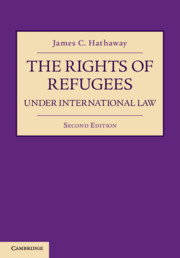Book contents
- The Rights of Refugees under International Law
- The Rights of Refugees under International Law
- Copyright page
- Dedication
- Epigraph
- Contents
- Table of Concordance to the Refugee Convention and Protocol
- Acknowledgments
- Table of Cases
- Table of Treaties and Other International Instruments
- Abbreviations for Courts and Tribunals Cited
- Introduction
- 1 The Evolution of the Refugee Rights Regime
- 2 An Interactive Approach to Interpreting Refugee Rights
- 3 The Structure of Entitlement under the Refugee Convention
- 4 Rights of Refugees Physically Present
- 5 Rights of Refugees Lawfully or Habitually Present
- 6 Rights of Refugees Lawfully Staying
- 7 Rights of Solution
- Book part
- Select Bibliography
- Index
5 - Rights of Refugees Lawfully or Habitually Present
Published online by Cambridge University Press: 10 March 2021
- The Rights of Refugees under International Law
- The Rights of Refugees under International Law
- Copyright page
- Dedication
- Epigraph
- Contents
- Table of Concordance to the Refugee Convention and Protocol
- Acknowledgments
- Table of Cases
- Table of Treaties and Other International Instruments
- Abbreviations for Courts and Tribunals Cited
- Introduction
- 1 The Evolution of the Refugee Rights Regime
- 2 An Interactive Approach to Interpreting Refugee Rights
- 3 The Structure of Entitlement under the Refugee Convention
- 4 Rights of Refugees Physically Present
- 5 Rights of Refugees Lawfully or Habitually Present
- 6 Rights of Refugees Lawfully Staying
- 7 Rights of Solution
- Book part
- Select Bibliography
- Index
Summary
As the degree of attachment between a refugee and a state party increases, so too do the rights which the refugee may claim. All of the rights acquired by simple physical presence – to enter and remain in the asylum state; freedom from arbitrary detention or penalization for illegal entry; protection of physical security; access to the necessities of life; protection of property; respect for family unity; free exercise of thought, conscience, and religion; access to basic education; documentation of identity and status; and to benefit from administrative assistance and access to the courts – continue for the duration of refugee status. But once a refugee is not only in fact under the jurisdiction of a state party to the Convention, but also lawfully present in that country, he or she acquires several additional rights.
- Type
- Chapter
- Information
- The Rights of Refugees under International Law , pp. 809 - 924Publisher: Cambridge University PressPrint publication year: 2021

